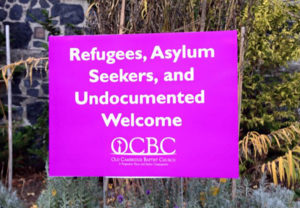 Practicing faith in community involves helping cultivate imagination for the possibility of living life beyond the restrictive dictates of an oppressive status quo and then faithfully living into that holy vision together. In Harvard Square these days, this means the renewal of sanctuary practice for the undocumented and those put at risk by current administration polities.
Practicing faith in community involves helping cultivate imagination for the possibility of living life beyond the restrictive dictates of an oppressive status quo and then faithfully living into that holy vision together. In Harvard Square these days, this means the renewal of sanctuary practice for the undocumented and those put at risk by current administration polities.
In the early 1980s, my congregation — Old Cambridge Baptist Church — took a Salvadoran trade unionist into sanctuary at the church after she was arrested and tortured on three occasions for her union organizing work in El Salvador (at the time, a regime supported by the U.S. government). About a month ago, the congregation unanimously voted to re-engage our sanctuary practice in light of the new administration’s aggressive policies and practices in relation to the undocumented. This time, however, we are cultivating sanctuary in rich interfaith community.
Our sanctuary coalition presently includes a Baptist church, a group of interfaith and secular seminary students, a Jewish minyan, a Lutheran church, a UCC church, and a United Methodist Church. We meet together weekly. We develop protocols together. We supply and beautify the sanctuary living space together. We seek training together on best practices for advocacy. We’ve accounted for the legal risks involved and we are clear on our commitment to one another and to the undocumented in our community. Our jointly cultivated covenant has three main components:
 We commit to building relationships with immigrants and refugees in our community, both documented and undocumented.
We commit to building relationships with immigrants and refugees in our community, both documented and undocumented.
We pledge to advocate on local, state, and federal levels for an end to unjust deportations.
We commit ourselves to the practice of sanctuary for those under threat of deportation, including providing physical Sanctuary when necessary.
Our covenant describes our commitment to sanctuary with a few of he key the ingredients that I believe have the effect of binding us closely together as a robust ecumenical and interfaith community in this work:
We’ve been drawn together through perceiving a “sacred calling.” As the political rhetoric began turning dangerous, this sense of call began to emerge in small conversations among members of these faith communities. It wasn’t clear at first what we had to do, but it was clear we had to do something. The call was rooted in our faith traditions’ commitment to “welcome the stranger, protect the vulnerable, and accompany the oppressed,” as the covenant now reads.
 We’ve discerned the necessity of sanctuary practice as a “moral duty.” As minority groups in our own community are placed in danger by increasing hostility whipped up by political rhetoric and families we know are put at risk of being torn apart by deportation, it is clear that practicing our faith commitments and following our emerging sense of call means protecting the valued and vulnerable members of our community.
We’ve discerned the necessity of sanctuary practice as a “moral duty.” As minority groups in our own community are placed in danger by increasing hostility whipped up by political rhetoric and families we know are put at risk of being torn apart by deportation, it is clear that practicing our faith commitments and following our emerging sense of call means protecting the valued and vulnerable members of our community.
We believe what we’re doing together is a practice of “holy resistance.” As immigrants and refugees and asylum-seekers and other minority groups in our community experience increasing danger because of their race, religion, sexual orientation, gender identity, or immigration status, our faith commitments won’t let us rest. Instead, our faith required us to risk. We don’t know what is to come for our sanctuary coalition or who will show up at the church door for the safety of sanctuary. We don’t know quite what all the repercussions will be if we remain faithful to our sense of call. The unknown and unpredictable is part of the genuine risk involved. But the sheer possibility bound up in the mystery makes it a holy risk worth taking.
The times in which we live beckon us all — every congregation and community of faith — to listen carefully for a sacred call from the living Spirit, to attend to the moral duties toward the vulnerable embedded in our faith tradition, and the practice the risk of holy resistance in ways that cultivate imagination for the possibility of living life beyond the restrictive dictates of an oppressive status quo and then faithfully living into that holy vision together.
